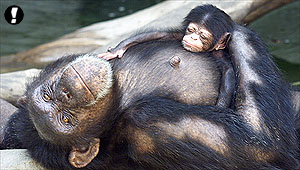A report on the state of monkeys published yesterday by the United Nations: within 3 decades, monkeys will have nowhere to live due to the destruction of most of their habitats by humans; A third of the orangutan population in Indonesia has been exterminated
Voila system! news

Chimpanzees. The situation is particularly serious in West Africa (Photo: Reuters)
The great apes, which are the closest animals to man, will have nowhere to exist within three decades, due to the destruction of most of their habitats. This is what a report on the condition of monkeys published yesterday by the United Nations at the Earth Conference in Johannesburg warns.
A team of experts on behalf of the United Nations estimates in the report that by 2030 only less than 10 percent of the area of the habitats of the gorillas and chimpanzees, the two great ape species that exist in Africa, will remain undamaged. The systematic destruction of the habitats is mainly caused by the conversion of large areas into mining and quarrying areas, the construction of roads that interrupt the habitats and various infrastructure programs, such as the transfer of gas and oil pipelines.
The pressures on the apes' habitats are particularly severe in West Africa, where there are still large populations of chimpanzees. These are mainly countries like the Ivory Coast and Gabon. There is also a threat to the habitats of the bonobo (dwarf chimpanzee), which is a rarer monkey. Only a quarter of this monkey's habitat area (about 100 square kilometers) remains with only minimal human influence.
Even worse is the situation of the orangutan, the other great ape whose habitats are mainly in Indonesia. In this area, according to estimates, about a third of the monkey population has already been destroyed, after the huge fires that were there four or five years ago. The experts estimate that if the current development trends do not change, the orangutan will have less than a percent of its habitat area left.
* The Hidan site was part of the IOL portal from the Haaretz group until 2002
